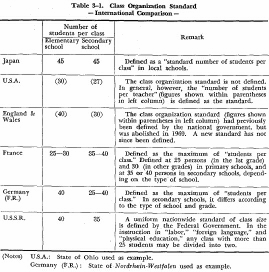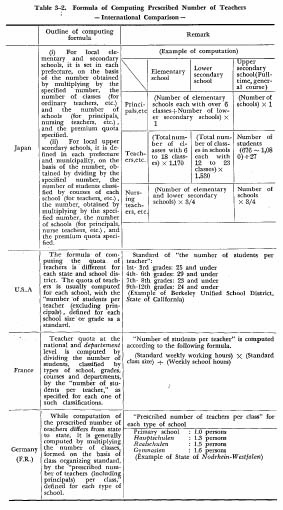| Home > Policy > White Paper, Notice, Announcement > White Paper > EDUCATIONAL STANDARDS IN JAPAN 1975 > CHAPTER3 1 (2) | ||
In Japan, under the terms of the Law Concerning Class Size andStandard of Prescribed Number of Educational Personnel in Local Compulsory Education Schools (hereafter to be called the "Standard Law") enacted in 1958 for the proper adjustment of class size and cducational personnel placement, and for the maintenance and enhancement ofstandards of compulsory education, the first five-year plan (1959-63) for the improvement of class organization and prescribed number of educational personnel was launched. With the standard number of pupils per class in local elementary and lower secondary schools set at 50 persons under this plan, measures were taken for elimination of the so-called"sardine-can c1asses." Under the subsequent second five-year plan thatbegan in the 1964 school year, measures were implemented for improvementof' class organization standards by such means as lowering the standard number of pupils per dass to 45 persons from previous 50, as well as for the increase in the prescribed number of educational personnel. And under the third five-year plan which started in the 1969 school year, further scrupulous measures for improvement of class organization standards were taken, such as removing single-class schools and multi-grade classes (each composed of pupils in four to five different grades) , on the one hand, while, on the other, steps were taken with regard to the prescribed number of educational personnel, such as securing at least three teachers, who are not in charge of a class, for each standard-size (18casses) elementary schools, and seeing that a nursing teaclter and a clericalstaff are also stationed in schools in remote areas.
At present, under the fourth five-year plan which started in the 1974 school year, further measures for improvement and completion have beenunder way. The major measures for improvement include the following.
Class Organization
(![]() ) To eliminate multi-grade classes in elementary schools,
eachcomposed of pupils in three different grades.
) To eliminate multi-grade classes in elementary schools,
eachcomposed of pupils in three different grades.
(![]() ) To improve the method of organizing multi-grade and specialclasses.
) To improve the method of organizing multi-grade and specialclasses.
Prescribed Number of Educational Personnel
(![]() ) To secure an adequate number of teachers in small-scale
lower secondary schools so as to eliminate cases of teachers taking charge of
sub.ject areas in which they have no teacher's certificate.
) To secure an adequate number of teachers in small-scale
lower secondary schools so as to eliminate cases of teachers taking charge of
sub.ject areas in which they have no teacher's certificate.
(![]() ) To increase the prescribed number of teachers in charge
of dormitoriese nursing teachers and clerical personnel.
) To increase the prescribed number of teachers in charge
of dormitoriese nursing teachers and clerical personnel.
(![]() ) To include school nutritionists in the framework of prescribed
number of the educational personnel, as specified in the Standard Law.
) To include school nutritionists in the framework of prescribed
number of the educational personnel, as specified in the Standard Law.
For local upper secondary schools as well, under the Law Concerning Establishment and Proper Distribution of Local Upper Secondary Schools and Standard of Prescribed Number of Educational Personnel Therein, Etc. enacted in 1961, the first five-year plan (1962-66) was launched. Uncler this plan, the standard number of students per class was defind at so (in a general course) as a principle both for full-time and part-time schools.
Under the subsequent five-year plan that began in the 1967 school year, the standard number of students per class was lowered in principle to 45 persons for a full-time course and 40 for a part-time course. Corresponding measures were also taken for improvement in the prescribed numder of educational personnel,
On the basis of the accomplishments of the first and second five-year plans, the third five-year plan was launched in the 1974 school year, under which further measures for improvement and completion nave been unaer way. Major measures for improvement include the following:
(![]() ) To secure an adequate number of teacher for part-time courses
in which student enrollment is short of the accomodation capacity, and for small-scale
full-time courses.
) To secure an adequate number of teacher for part-time courses
in which student enrollment is short of the accomodation capacity, and for small-scale
full-time courses.
(![]() ) To increase the prescribed number of correspondence course
teachers.
) To increase the prescribed number of correspondence course
teachers.
(![]() ) To increase the prescribed number of nursing teachers,
etc.
) To increase the prescribed number of nursing teachers,
etc.


The outline of class organization standards and the formula for the computation of the prescribed number of teachers in several selected countries are summarized in Tables 3-1 and 3 -2 respectively. In the case of class organization standards, simple comparison cannot be made, since its contents and the method of its application differ from country to country. In the United Staes and England & Wales, there are no statutory provisions on this standard at present. In France and the Federal Republic of Germany, the method of the applying the standard differs according to the type of school and grade.
With regard to the formula for computing the prescribed number of teachers, detailed provisions are made in Japan under the Standard Law, as mentionecl before. The prescribed number of teachers is computed on tlae basis of the number of classes in local elementary ana lower secondarv schools and on the basis of the number of students in local upper secondary schools. No statutory provisions on the formula for cormputing the prescribed number of teachers are found in other countries except in the Federal Republic of Germany. The required number of teachers is computed on the basis of students per teacher in the United States and France, and on the basis of the number of teachers per class in the Federal Republic of Germany.
| Back to Top | MEXT HOME |